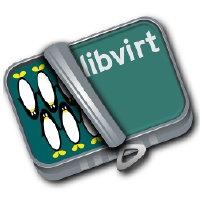
Virtualization
Run virtual machines at near-native speeds and manage them at ease

Run virtual machines at near-native speeds and manage them at ease
In a headless virtual machine hosts accessible by SSH, the activities on a virtual machines can be discovered by offloading the console prompts on the current TTY. This is a great alternative to setting up SSH inside the virtual machine or connecting to the virtual machine via VNC or SPICE.
/boot directory of the Fedora installation of the host to grab some kernel and initramfs images.
$ cd /boot
$ ls -l vmlinuz-*
-rwxr-xr-x. 1 root root 10580240 Jul 12 00:09 vmlinuz-0-rescue-8ee701c92f0f486cbb7afe96e5b7ea67
-rwxr-xr-x. 1 root root 10853744 Jul 21 02:13 vmlinuz-5.13.4-200.fc34.x86_64
-rwxr-xr-x. 1 root root 10851312 Jul 25 22:05 vmlinuz-5.13.5-200.fc34.x86_64
-rwxr-xr-x. 1 root root 10850800 Jul 28 21:17 vmlinuz-5.13.6-200.fc34.x86_64
linxkrnl and the initramfs images to a reference directory initrmfs.
$ sudo cp /boot/vmlinux-* linxkrnl/
$ sudo cp /boot/initramfs-* initrmfs/
linxkrnl and initrmfs respectively.
$ sudo chown $(whoami):$(whoami) linxkrnl/ --recursive
$ sudo chown $(whoami):$(whoami) initrmfs/ --recursive
$ ls -l linxkrnl/
total 42136
-rwxr-xr-x. 1 t0xic0der t0xic0der 10580240 Aug 2 15:35 vmlinuz-0-rescue-8ee701c92f0f486cbb7afe96e5b7ea67
-rwxr-xr-x. 1 t0xic0der t0xic0der 10853744 Aug 2 15:35 vmlinuz-5.13.4-200.fc34.x86_64
-rwxr-xr-x. 1 t0xic0der t0xic0der 10851312 Aug 2 15:35 vmlinuz-5.13.5-200.fc34.x86_64
-rwxr-xr-x. 1 t0xic0der t0xic0der 10850800 Aug 2 15:35 vmlinuz-5.13.6-200.fc34.x86_64
$ ls -l initrmfs/
total 179496
-rw-------. 1 t0xic0der t0xic0der 84860404 Aug 2 15:36 initramfs-0-rescue-8ee701c92f0f486cbb7afe96e5b7ea67.img
-rw-------. 1 t0xic0der t0xic0der 33023557 Aug 2 15:36 initramfs-5.13.4-200.fc34.x86_64.img
-rw-------. 1 t0xic0der t0xic0der 33002599 Aug 2 15:36 initramfs-5.13.5-200.fc34.x86_64.img
-rw-------. 1 t0xic0der t0xic0der 32910001 Aug 2 15:36 initramfs-5.13.6-200.fc34.x86_64.img
$ qemu-system-x86_64 \
-boot menu=on \
-m 2048 \
-cpu max \
-smp 4 \
-drive file=datadrct/fedobios.raw,format=raw \
-accel kvm
$ cat /proc/cmdline
BOOT_IMAGE=(hd0,msdos1)/vmlinuz-5.11.12-300.fc34.x86_64 root=UUID=0fa356e9-9509-4e18-8283-8983254c79d1 ro rhgb quiet
Take a note of the UUID for the root partition and the same can be confirmed by executing the following command in a terminal session inside the virtualized domain.
$ cat /etc/fstab
#
# /etc/fstab
# Created by anaconda on Mon Aug 2 09:36:54 2021
#
# Accessible filesystems, by reference, are maintained under '/dev/disk/'.
# See man pages fstab(5), findfs(8), mount(8) and/or blkid(8) for more info.
#
# After editing this file, run 'systemctl daemon-reload' to update systemd
# units generated from this file.
#
UUID=0fa356e9-9509-4e18-8283-8983254c79d1 / ext4 defaults 1 1
UUID=2d2863bb-527b-4477-bae5-5955bdb44d7b /boot ext4 defaults 1 2
$ qemu-system-x86_64 \
-boot menu=on \
-m 2048 \
-cpu max \
-smp 4 \
-drive file=datadrct/fedobios.raw,format=raw \
-accel kvm \
-nographic \
-kernel linxkrnl/<vmlinuz-x.yy.zz-aaa.fcRR.x86_64> \
-initrd initrmfs/<initramfs-x.yy.zz-aaa.fcRR.x86_64.img> \
-append "root=UUID=<xxxxxxxx-xxxx-xxxx-xxxx-xxxxxxxxxxxx> rw console=ttyS0"
systemd prompts would show up on the console and the virtualized domain would boot up. The following is an example output for the above command.
...
[ OK ] Started Network Manager Script Dispatcher Service.
[ OK ] Finished Network Manager Wait Online.
[ OK ] Reached target Network is Online.
[ OK ] Reached target Remote File Systems (Pre).
[ OK ] Reached target Remote File Systems.
Starting Virtualization daemon...
Starting Notify NFS peers of a restart...
Starting Permit User Sessions...
[ OK ] Started Notify NFS peers of a restart.
[ OK ] Finished Permit User Sessions.
Starting GNOME Display Manager...
Starting Hold until boot process finishes up...
[ OK ] Started GNOME Display Manager.
Fedora 34 (Workstation Edition)
Kernel 5.13.6-200.fc34.x86_64 on an x86_64 (ttyS0)
fedorable login: t0xic0der
Password:
Last login: Tue Aug 3 09:31:12 on tty2
[t0xic0der@fedorable ~]$
$ ip a
1: lo: <LOOPBACK,UP,LOWER_UP> mtu 65536 qdisc noqueue state UNKNOWN group default qlen 1000
link/loopback 00:00:00:00:00:00 brd 00:00:00:00:00:00
inet 127.0.0.1/8 scope host lo
valid_lft forever preferred_lft forever
inet6 ::1/128 scope host
valid_lft forever preferred_lft forever
As evidenced by the output of the above command executed inside the console of the virtualized domain, the kernel modules for network are apparently broken and the hostname of the host is taken up by the virtualized domain due to the mismatch of kernel images, initramfs images and installed firmware versions.
Authors: Akashdeep Dhar, Jarek Prokop, Nick Dirschel